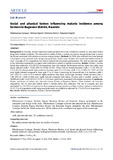| dc.contributor.author | Cyriaque, M. | |
| dc.contributor.author | Ngomi, Nicholas N. | |
| dc.contributor.author | Monica, M. | |
| dc.contributor.author | Erigene, R. | |
| dc.date.accessioned | 2021-03-24T12:25:37Z | |
| dc.date.available | 2021-03-24T12:25:37Z | |
| dc.date.issued | 2020-07 | |
| dc.identifier.citation | Life Research 2020, 3 (3): 125–130. | en_US |
| dc.identifier.uri | http://erepository.mkuit.ac.rw/handle/123456789/6699 | |
| dc.identifier.uri | http://hdl.handle.net/123456789/4558 | |
| dc.description.abstract | Background: In Rwanda, farmers experience health problems due to the consistency increase in mosquitoes which bring about malaria incidence. We researched to realize if there is malaria occurrence among farmers and to assess the factors associated with malaria occurrence among farmers.
Methods: In 2019, data collected was done through a descriptive cross-sectional study design among farmers, health center workers and community health workers in rural. A sample of 384 respondents was used to respond the structured questionnaires. We used an interview guide to key informant respondents to support other information related to malaria occurrence.
Results: Within 3 months before data collection, 342 (89.1%) of respondents have had malaria. Multivariate analysis shows that males were highly infected (AoR = 19.60; 95% CI: 9.049–42.452). Those with no formal education (AoR = 11.10; 95% CI: 3.128–39.433) demonstrated high incidence. Farmers aged 15 to 25 years (AoR = 13.44; 95% CI: 5.257–34.358) were highly infected compared to those aged 37 to 47 years. Concerning the household size, 4–6 members (AoR = 5.97; 95% CI: 1.919–18.574) showed higher incidence than those above eight members. Public servants (AoR = 7.00; 95% CI: 2.669–18.394) were highly infected compared with traders. Farmers with a monthly income of 0–50,000 rwf (AoR = 6.65; 95% CI: 2.079–21.324) were significantly associated with malaria occurrence.
Conclusion: Higher prevalence of malaria was observed among farmers in Bugesera District. Three hundred and forty-two respondents (89.1%) have had malaria within 3 months before data collection. The use of mosquito nets was highlighted by 119 (31%) of respondents. Encouraging farming direction can help to reduce malaria as indicated by 81 (21.1%) of respondents while using insecticide-spray was helpful as indicated by 172 (44.8%) of respondents. | en_US |
| dc.language.iso | en | en_US |
| dc.subject | Malaria, Occurrence, Farmers, Factors associated | en_US |
| dc.title | Social and physical factors influencing malaria incidence among farmers in Bugesera District, Rwanda | en_US |
| dc.type | Article | en_US |

